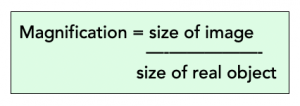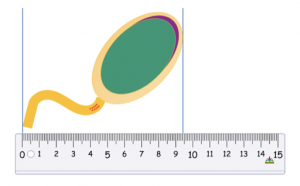Magnification and Resolution (A-level Biology)
Magnification and Resolution
Magnification
- Magnification involves making something bigger. In microscopy, magnification is the ability to make the image of a specimen larger than a specimen actually is.
- Special glass lenses magnify the image. Microscopes use specialised glass lenses which alter the light passing through a specimen in order to magnify its image. The image can be viewed by the observer or can be projected on a screen.
- To calculate magnification, you must know the size of the image and the size of the real object.

Worked Example
Example: A sperm cell measures 10μm in length. Please calculate the magnification of this image.
1. Work out image size

9.4cm
2. Convert into correct units
cm —> μm (Multiply by 10000) 9.4cm = 94000 μm
3. Rearrange Formula
Magnification = Image Size ÷ Actual Size
4. Put the numbers in
Magnification = 94000 ÷ 10 = 9400x
Resolution
- Resolution of an image is a measure of detail. Resolution is a numerical measure of how detailed and clear an image is.
- Resolution of a microscope is its ability to distinguish two close points. Resolution is a measure of the microscope’s ability to distinguish between two points which are close together on an object. If a microscope can clearly distinguish between the two points, it has a good or high resolution.
FAQs
Magnification in biology refers to the increase in size of an object when it is viewed through a microscope or other optical device. The magnification is expressed as a ratio, with the size of the object in the microscope being the numerator and the actual size of the object being the denominator.
Magnification refers to the increase in size of an object when viewed through a microscope, while resolution refers to the ability of a microscope to distinguish between two separate objects that are close together. The higher the resolution of a microscope, the better it is able to separate objects that are close together and to provide clear, detailed images.
The formula for calculating magnification is simply the size of the object in the microscope divided by the actual size of the object. For example, if a cell is viewed under a microscope and appears to be 10 times larger than its actual size, the magnification would be 10x.
The magnification of a microscope is determined by several factors, including the type of lens used, the distance between the lens and the object, and the size of the eyepiece. Additionally, the type of microscope being used, such as a compound microscope or a electron microscope, can also impact the magnification.
The type of lens used in a microscope can have a significant impact on the magnification of the microscope. For example, using a higher power objective lens will increase the magnification, while using a lower power objective lens will decrease the magnification.
The distance between the lens and the object being viewed can also affect the magnification. Increasing the distance between the lens and the object will decrease the magnification, while decreasing the distance will increase the magnification.
Understanding magnification and resolution in biology is important because it allows students to understand how microscopes work and to interpret the images they see through the microscope. This understanding is essential for studying the structures and functions of cells, tissues, and organs, as well as for investigating diseases and conditions at the cellular and molecular levels.
It is difficult to increase both magnification and resolution at the same time. Increasing the magnification usually decreases the resolution, while increasing the resolution usually decreases the magnification. To achieve the best results, it is important to balance the magnification and resolution based on the needs of the experiment or investigation.






Still got a question? Leave a comment
Leave a comment